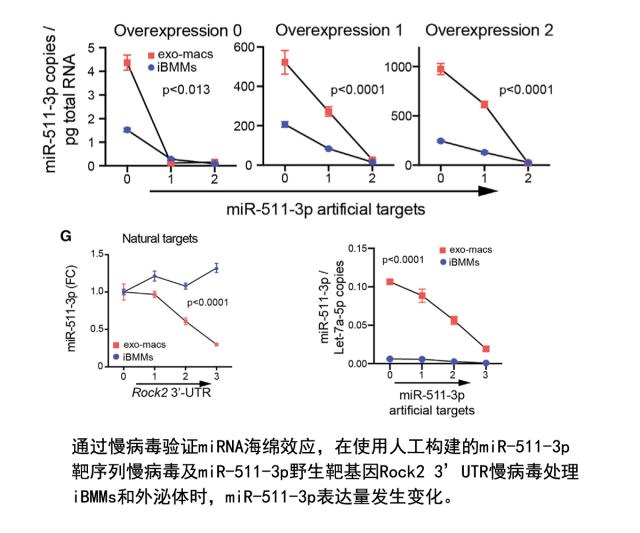2013年,美国、德国3位科学家凭借他们所发现的细胞囊泡运输的调节机制,荣获2013年诺贝尔生理学或医学奖。外泌体(exosomes)作为人体内一类重要囊泡,也开始受到越来越多的关注。科学家们已发现,外泌体会参与到免疫应答、凋亡、血管生成、炎症反应、凝结等重要的生物过程中,细胞会通过分泌外泌体,将一些信号分子分泌到较远的组织或细胞中,以起到调控作用,不过整个过程的机制目前尚未阐明。
8月21日,来自瑞士的研究者在Cell Reports杂志撰文发布了他们关于外泌体miRNA的最新研究成果。
在该项研究中,研究者选择骨髓巨噬细胞(bone marrow-derived macrophages, BMDM)和血管上皮细胞(endothelial cells, ECs)作为样本,希望了解miRNA从细胞分配进入外泌体的机制及外泌体miRNA对受体细胞的影响。利用qPCR检测,研究者发现,当细胞中miRNA表达量出现变化时,外泌体中相应miRNA也会出现相同变化趋势,但变化幅度会更大。若使用特殊结构慢病毒处理细胞,发现当细胞中包含miRNA的3’UTR结合位点的转录本表达上升时,miRNA的表达量会相应出现下调,而且外泌体中的变化幅度依然比细胞中大,研究者将这种现象称为“miRNA海绵效应”。为了验证这种效应,研究者通过RNA-Seq检测了IL-4处理后的BMDM,结果发现有7000多个转录本出现表达差异,通过计算模型分析,研究者证明,这个miRNA海绵效应,实际上是细胞在受到刺激时,某些转录本转录状态会出现变化,从而影响一些靶序列位于这些转录本上的miRNA,并分配他们进入外泌体中,但细胞内的miRNA水平则不会受到影响。
而为了研究外泌体运输所介导的细胞通讯,研究者使用慢病毒构建出一种荧光标记的BMDM外泌体,并用此外泌体处理血管上皮细胞(endothelial cells, ECs),qPCR检测则发现,某些从BMDMs富集到外泌体中的miRNA,在ECs中也出现明显上调;利用流式细胞仪检测发现,外泌体被ECs吞下,且最终可能在溶酶体中被分解,但研究者通过构建特殊慢病毒的手段,保证外泌体中的miRNA能够保留其基因调控功能。经过RNA-Seq分析,也证明ECs中miRNA的靶基因确实受到了miRNA的调控。这些数据表明,巨噬细胞确实会利用外泌体运输miRNA,通过内吞作用进入其他细胞并发挥调控作用,以起到远程调控的功能。

随着研究的不断深入,人们日益认识到,外泌体所包含的miRNA可能会成为诊断和治疗某些疾病的特殊标志物,而本研究的意义在于,它不仅鉴定出了miRNA由细胞分选进入外泌体的通用机制,也阐述了外泌体进入受体细胞后其中所包含的miRNA的功能及命运,是对现有外泌体miRNA研究的重要推动。
MicroRNA (miRNA) transfer via exosomes may mediate cell-to-cell communication. Interestingly, specific miRNAs are enriched in exosomes in a celltype-dependent fashion. However, the mechanisms whereby miRNAs are sorted to exosomes and the significance of miRNA transfer to acceptor cells are unclear.We used macrophages and endothelial cells (ECs) as a model of heterotypic cell communication in order to investigate both processes. RNA profiling of macrophages and their exosomes shows that miRNA sorting to exosomes is modulated by cellactivation-dependent changes of miRNA target levels in the producer cells. Genetically perturbing the expression of individual miRNAs or their targeted transcripts promotes bidirectional miRNA relocation from the cell cytoplasm/P bodies (sites of miRNA activity) to multivesicular bodies (sites of exosome biogenesis) and controls miRNA sorting to exosomes. Furthermore, the use of Dicer-deficient cells and reporter lentiviral vectors (LVs) for miRNA activity shows that exosomal miRNAs are transferred from macrophages to ECs to detectably repress targeted sequences.
